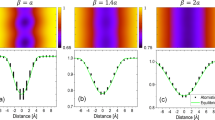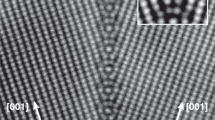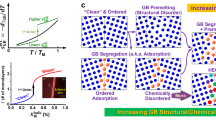Abstract
ACCORDING to the transition lattice theory, since in pure metals and single-phase alloys the only difference between the two grains which meet at a boundary is one of direction, the atoms at the boundary take up positions representing a compromise between the two crystal lattice directions. There thus exists a region, a few atomic diameters in thickness, over which a state of disorder exists, the extent of which will be expected to depend upon the relative orientation of the two lattices; there will exist angles for which this disorder is a minimum, an obvious example being the twinning angle. In addition, the direction of the boundary itself relative to the grains would be expected to produce an effect. Lateral misalignment of crystal planes would also be expected to produce ‘lack of fit’ at the grain boundaries, but this effect is most probably smoothed out by the imperfections in the crystal structure. It would be expected, therefore, that any phenomenon depending upon the degree of disorder existing at the boundary would vary in magnitude according to the relative orientations of the grains meeting at the boundary, and with position in the boundary between two given crystal grains if the boundary changed in direction. It is reasonable to suppose that where precipitation of a second phase occurs from the supersaturated solid solution, it occurs more readily in those regions where disorder is greatest, and it would, therefore, be expected that grain boundary precipitation would vary in this manner.
This is a preview of subscription content, access via your institution
Access options
Subscribe to this journal
Receive 51 print issues and online access
$199.00 per year
only $3.90 per issue
Buy this article
- Purchase on Springer Link
- Instant access to full article PDF
Prices may be subject to local taxes which are calculated during checkout
Similar content being viewed by others
References
Shuttleworth, R., King, R., and Chalmers, B., Nature, 158, 482 (1946).
Author information
Authors and Affiliations
Rights and permissions
About this article
Cite this article
FORSYTH, P., KING, R., METCALFE, G. et al. Grain Boundaries in Metals. Nature 158, 875–876 (1946). https://doi.org/10.1038/158875a0
Issue Date:
DOI: https://doi.org/10.1038/158875a0
This article is cited by
-
Prior austenite grain boundary recognition in martensite microstructure based on deep learning
Journal of Iron and Steel Research International (2023)
-
A Forward Modeling Approach to High-Reliability Grain Mapping by Laboratory Diffraction Contrast Tomography (LabDCT)
JOM (2019)
-
Mechanism of the formation of lamellar M23C6 at and near twin boundaries in austenitic stainless steels
Metallurgical and Materials Transactions A (1999)
-
Atomic mechanisms of diffusional nucleation and growth and comparisons with their counterparts in shear transformations
Metallurgical Transactions A (1993)
-
Systematics of the cellular precipitation reactions
Metallurgical Transactions (1972)
Comments
By submitting a comment you agree to abide by our Terms and Community Guidelines. If you find something abusive or that does not comply with our terms or guidelines please flag it as inappropriate.



